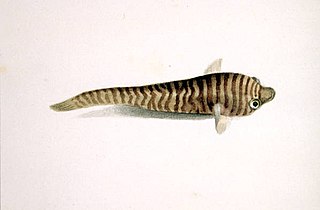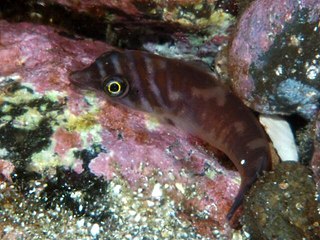The New Zealand urchin clingfish is a clingfish, the only species in the genus Diplocrepis. It is found around New Zealand wherever sea urchins are present. Its length is between 2 and 3 cm.
Kuiter's deepsea clingfish is a clingfish of the family Gobiesocidae, found only off New South Wales, Australia, at depths of between 90 and 110 m.

The Tasmanian clingfish is a clingfish of the family Gobiesocidae, found around the western and southern coasts of Australia including Tasmania. Its length is up to 8 cm. This species is found in shallow, coastal, rocky reefs and in the intertidal zone. It is also encountered by scuba divers beneath piers and jetties.

Angophora leiocarpa is a tree species that is native to eastern Australia. It grows to 25 metres in height and has smooth grey to cream bark that sheds in small patches revealing pink underneath. Its range extends northwards from Grafton in New South Wales to Queensland.
Acyrtops is a genus of clingfishes native to the western Atlantic Ocean.

Apletodon is a genus of marine fish in the family Gobiesocidae (clingfishes). The genus was first named by John Carmon Briggs in 1955.

Arcos is a genus of clingfishes.

Aspasmogaster is a genus of clingfishes native to the Indian and Pacific Oceans.
Briggsia hastingsi is a species of clingfish so far only known from Rahah Bay, Oman. This species grows to a length of 2.2 centimetres (0.87 in) SL. This species is the only known member of its genus. It was described in 2009 from the only known specimen by Matthew T. Craig and John E. Randall. The generic name honours the clingfish systematicist John Carmon Briggs (1920-2018) of the Georgia Museum of Natural History while the specific name honours Philip A. Hastings of the Scripps Institute of Oceanography, who was the PhD supervisor of Matthew T. Craig and who sparked his interest in clingfishes.

Chorisochismus dentex, the rocksucker or giant clingfish, is a species of clingfish found along the coast of southern Africa from Namibia to northern Natal, South Africa. It inhabits the intertidal and subtidal zones in shallow reefs and rock pools. This species is the only known member of its genus.

Diplecogaster is a genus of fish in the family Gobiesocidae found in Black Sea, Mediterranean Sea and Atlantic Ocean.

Lepadogaster candolii, common name Connemarra clingfish, is a species of fish in the genus Lepadogaster. It occurs in the Eastern Atlantic from the British Isles south to Madeira and the Canary Islands and into the western Mediterranean and the Black Sea. The specific name candolii has various spellings: candolii, candolei, candollei, and decandollii, but only the first one is correct.

Cochleoceps orientalis, common name eastern cleaner-clingfish, is a species of clingfish that is endemic to the marine waters around southeastern Australia.

Apletodon incognitus is a species of clingfish of the family Gobiesocidae. The species is endemic to north-eastern Atlantic Ocean to north-western Mediterranean Sea. The juvenile fish which measure around 1–2 centimetres (0.39–0.79 in) standard length (SL) are frequently recorded as having an association with sea urchins and in beds of Posidonia oceanica. The adults hide under stones covered with red coralline algae and in the empty shells of mussels near beds of Posidonia and Cymodocea nodosa. Within the beds of Posidonia it is often found in sympatry with Opeatogenys gracilis.
The São Tomé clingfish is a species of marine fish of the family Gobiesocidae (clingfish). It grows to 1.4 cm maximal length. It occurs in the eastern Atlantic Ocean, around the islands of São Tomé and Príncipe between 0 and 3 metres depth. The species was first described in 2007 by Ronald Fricke, its specific name honouring the collector of the type, marine biologist Peter Wirtz of Madeira.

The common shore eel is a species of clingfish from Australia. It is generally found in the south-eastern waters of Australia. It usually grows to about 12 cms. Often found by beachgoers after looking in rock-pools and turning over shells.
The dwarf shore eel is a species of clingfish from the family Gobiesocidae.It is a small species which attains a maximum total length of 4.5 centimetres (1.8 in). This species is transparent and its internal organs are clearly visible through its skin. It occurs at depths of 0 to 5 metres within beds of seagrass and sometimes in nearby reefs. It is endemic to southern Australia where its range extends from near Sydney in New South Wales to Houtman Abrolhos in Western Australia, including the northern and eastern coasta of Tasmania. This species was described by Victor G. Springer and Thomas H. Fraser in 1976 and the specific name honours the ichthyologist Douglass F. Hoese of the Australian Museum who provided Springer and Fraser with much of the material they used in their description.
The pygmy shore eel is a species of clingfish from the family Gobiesocidae. It is endemic to south eastern Australia where it can be found wityhin seagrass beds and sometimes on rocky reefs at depths of less than 10 metres (33 ft) from Point Cartwright in Queensland to Flinders Island, South Australia; its range includes Tasmania. This species was described as Cheilobranchus parvulus by Allan Riverstone McCulloch in 1909 from a type locality of rockpools near Sydney.
Apletodon dentatus, the small-headed clingfish, is a species of clingfish from the family Gobiesocidae. It is a benthic fish of shallow, rocky water on the coasts of the eastern Atlantic Ocean and the western Mediterranean Sea.










